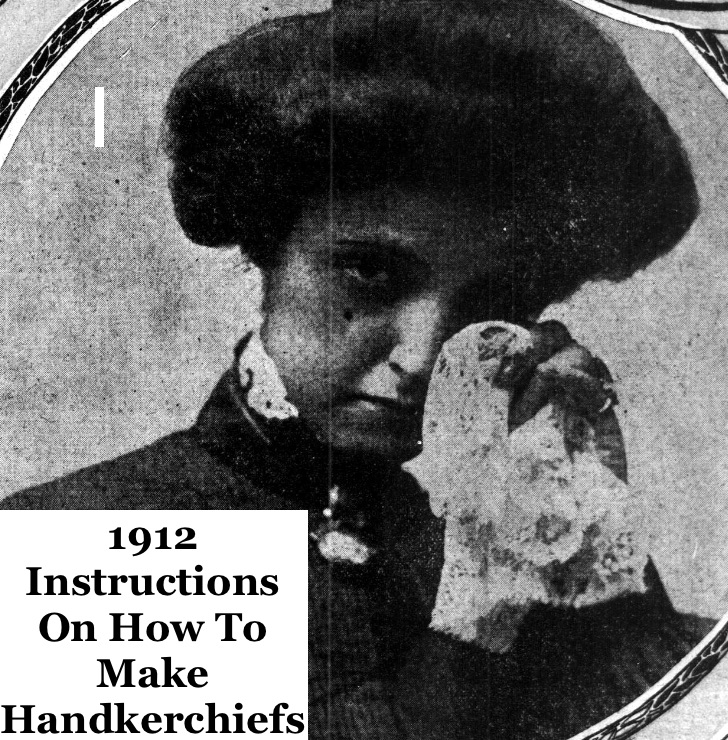
While the title of the original article makes one think it is about gifting handkerchiefs, the meat of the article talks about how handkerchiefs are made and embellished. For those looking to learn how to make their own handkerchiefs the old fashioned way, this article explains the method perfectly.

Handkerchief as a Gift
By Louise Gunton
It may be because of a deplorable lack of originality, but the fact remains that after a person has anxiously gone through a list of gifts the prices of which are within the limit set, has rejected them all as being unsuitable to the person in mind, she decides on a half dozen handkerchiefs, or even a single one, as being a pretty and useful present and one that is likely to be satisfactory to giver and recipient alike.
It can be made original with very little trouble. In the first place, embroider or have embroidered in one corner the monogram or initials of the one for whom the handkerchief is intended. A pretty idea is to cut out your friend’s signature from the bottom of a latter, place it against the window pane with the handkerchief on top, and trace the name in pencil upon the linen, then embroider in outline with white cotton.
Instead of sending it in the regulation holly covered box in which it came from the shop, inclose it in a dainty Japanese envelope, repeating the monogram or name upon the envelope in water colors or crayons, or lettering in a Christmas greeting.
Another oriental way of doing up a Christmas handkerchief is to take two Japanese crepe doilies, place a little sachet pad between them, and lace them together with narrow ribbon, tying a bow in the center of each side. Then, having folded the handkerchief into a quarter square, lay it on the top doily, diagonally, and slip each corner of the handkerchief under a bow of ribbon. Write a greeting on a little Japanese hand painted place card and slip it into the fold of the handkerchief.
Fine sheer handkerchiefs are easily made at home and cost much less than when bought at the store. Instead of hemming the edges they should be rolled French fashion. Dampen the thumb and first finger of the left hand and roll as finely as possible as you continue to sew. The lace edging or insertion that you trim with should be sewed on with the same stitch that sews the roll. In other words, the roll and edging are sewed at the same time.
So seldom is there anything new introduced in the line of handkerchiefs that anything out of the ordinary is sure to attract attention. The latest handkerchief novelty has the appearance of an ordinary handkerchief, is made of fine material with hemstitched border, and may have a small embroidered figure in the corner. The novel feature of this handkerchief is that it is made with a four inch diamond shaped center of white velveteen outlined with fine lace edging. This center takes the place of the chamois, so essential to the handbag toilet of the average young woman. Powder can be dusted upon the chamois velvet center, and it clings to the nappy face even better than to the surface of a chamois skin. Being concealed in the center of the handkerchief, it is never noticed when in ordinary use or when carried loosely in the hand. The center launders as perfectly as the balance of the handkerchief, making it an ideal article whether with or without the use of powder. It is easily made and would make an attractive gift if placed in a fancy holiday box.
Two handkerchiefs, either plain hemstitched or embroidered, will make a handsome corset cover with the addition of lace insertion, edging, and ribbon. Take one handkerchief and cut in two pieces from corner to corner; then take the other handkerchief and cut in two pieces the same way; then take one of these pieces and cut in halves from corner to corner again. There are now three large triangle and two small ones. Take two of the large pieces for the bottom, with the other large piece fitting at the top. Place a small piece at each side.
All these pieces are put together by a double row of insertion, forming a straight oblong piece when finished. If cut as indicated, one can readily see how they are pieced together. Edge the top and bottom with beading to run ribbon through, being wider at the bottom than at the top. Put a double row of insertion down each side at the front, the side which buttons over having also a ruffle of lace. The straps for the arms are made from bands of beading or embroidery edged with lace. This corset cover may be increased in size simply by adding extra rows of insertion and beading.
The fine linen handkerchief, with a hemstitched edge and Mexican drawn work decoration, is a suitable one from which to make a sailor collar, pointed at the back, for a young girl. You have only to fold is three-cornerwise and make a scissors slash from one corner in to one inch beyond the exact center. Then place the handkerchief round the neck and trim away a little of the linen at the back and sides of the neck. Slope it gradually down to the front points. Bind this cut edge with a narrow strip of linen. Cuffs to match may be added by cutting a duplicate handkerchief diagonally in half and binding the raw edges.
Source: The Washington herald. (Washington, D.C.), 24 Nov. 1912.

